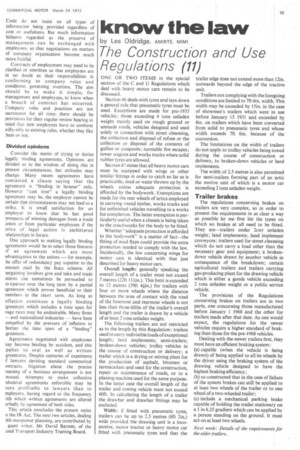know the law
Page 57

If you've noticed an error in this article please click here to report it so we can fix it.
by Les Oldridge, AMIRTE. MIMI
The Construction and Use Regulations (11)
ONE OR. TWO ITEMS in the special section of the C and U Regulations which deal with heavy motor cars remain to be discussed.
Section 46 deals with tyres and lays down a general rule that pneumatic tyres must be used. Exceptions are made for pre-1933 vehicles; those exceeding 4 tons unladen weight mainly used on rough ground or unmade roads, vehicles designed and used solely in connection with street cleansing, the collection and disposal of refuse or the collection or disposal of the contents of gullies or cesspools; turntable fire escapes; tower wagons and works trucks where solid rubber tyres are allowed.
Section 47 states that all heavy motor cars must be equipped with wings or other similar fittings in order to catch so far as is practicable, mud or water thrown up by the wheels unless adequate protection is afforded by the bodywork. Exemptions are made for the rear wheels of artics employed in carrying round timber, works trucks and for unfinished vehicles travelling to a works for completion. The latter exemption is particularly useful when a chassis is being taken to the coachworks for the body to be fitted.
Whether "adequate protection is afforded to the bodywork" is a matter of fact—the fitting of mud flaps could provide the extra protection needed to comply with the law. Incidentally, the law concerning wings for motor cars is identical with that just described for heavy motor cars.
Overall length: generally speaking the overall length of a trailer must not exceed 7 metres (22ft I This limit is extended to 12 metres (39ft 4iin.) for trailers with four or more wheels where the distance between the area of contact with the road of the foremost and rearmost wheels is not less than three-fifths of the trailer's overall length and the trailer is drawn by a vehicle • of at least 2 tons unladen weight.
The following trailers are not restricted as to the length by this Regulation: trailers used to carry indivisible loads of exceptional length ; land implements; semi-trailers; broken-down vehicles; trolley vehicles in the course of construction or delivery; a trailer which is a drying or mixing plant for the production of asphalt, bitumen or tarmacadam and used for the construction, repair or maintenance of roads, or to a planing machine used for the same purpose. In the latter case the overall length of the trailer and towing vehicle must not exceed 60ft. In calculating the length of a trailer the drawbar and drawbar fittings may be excluded.
Width: if fitted with pneumatic tyres, trailers can be up to 2.5 metres (8ft 2in.) wide provided the drawing unit is a locomotive, motor tractor or heavy motor car fitted with pneumatic tyres and that the trailer edge does not extend more than 12in. outwards beyond the edge of the tractive unit.
Trailers not complying with the foregoing conditions are limited to 7ft 6in. width. This width may be exceeded by 15in, in the case of showmen's trailers which were in use before January 15 1931 and exceeded by 6in. on trailers which have been converted from solid to pneumatic tyres and whose width exceeds 7ft 6in. because of the conversion.
The limitations on the width of trailers do not apply to trolley vehicles being towed during the course of construction or delivery, to broken-down vehicles or land implements.
The width of 2.5 metres is also permitted for semi-trailers forming part of an artic the motive unit of which is a motor car exceeding 2 tons unladen weight.
Trailer brakes
The regulations concerning brakes on trailers are very complex, so in order to present the requirements in as clear a way as possible let me first list the types on which no brakes at all need to be fitted.
They are—trailers under 2cwt unladen weight; land implements; land implement conveyors; trailers used for street cleansing which do not carry a load other than the necessary gear and equipment; a broken down vehicle drawn by another vehicle in consequence of. the breakdown; certain agricultural trailers and trailers carrying gas-producing plant for the drawing vehicle which is either a goods vehicle exceeding 2 tons unladen weight or a public service vehicle.
The provisions of the Regulations concerning brakes on trailers are in two parts, one concerning those manufactured before January 1 1968 and the other for trailers made after that date. As one would expect, the regulations for the newer vehicles require a higher standard of braking than those for the pre-1968 vehicles.
Dealing with the newer trailers first, they must have an efficient braking system: (a) capable (when the vehicle is being drawn) of being applied to all its wheels by the driver using the braking system of the drawing vehicle designed to have the highest braking efficiency; (b) so constructed that in the case of failure of the system brakes can still be applied to at least two wheels of the trailer or to one wheel of a two-wheeled trailer; (c) include a mechanical parking brake capable of holding the trailer stationary on a I in 6.25 gradient which can be applied by a person standing on the ground. It must act on at least two wheels.




















































































































































